|
Geology Quicklinks Formation of the Dunes | Hydrology | Singing Sand Phenomenon Dune Types | Sand System Components | Magnetite Sand | Research Links Descriptive TranscriptThis 60-second animation depicts the formation of the dunes. Through the video, the corresponding dates scroll rapidly from 400,000 years ago to present day. There is no audio. 1) 400,000 years ago: The San Luis Valley is flanked by the San Juan Mountains on the left and Sangre de Cristo Mountains on the right. The valley is filled with sediments left behind by a large lake that once covered the valley. The text reads: "The subsiding rift valley created a depression that filled with sandy sediment." 2) 120,000 years ago: The mountains and valley are covered with glaciers and snow, which then melts away into intermittent lakes fed by streams. The text reads: "Over thousands of year, melting glaciers filled the valley with streams and lakes where sand was deposited." 3) 60,000 - 3,000 years ago: Repeated glaciation is followed by the intermittent appearance of lakes then sand deposits left behind as the lakes recede. Streaks of wind are depicted, blowing sand from the lakebeds into a pocket of the Sangre de Cristo Mountains. The text reads: "Prevailing winds pushed sand up against the base of the mountains. Migrating dunes moved easily in the open valley due to lack of vegetation." 4) 3,000 years ago to Present Day: The animation zooms into the forming dunefield, which continues to grow at the base of the mountains. Storm winds periodically reverse the dune ridges, causing them to oscillate with the opposing wind directions. The line of Medano Creek is on the southern edge of the dunefield. The text reads: "Multiple wind directions along the mountain front have caused the dunes to grow to their impressive height."
Visit our keyboard shortcuts docs for details
This 60-second animation depicts the formation of the dunes. Through the video, the corresponding dates scroll rapidly from 400,000 years ago to present day. There is no audio. 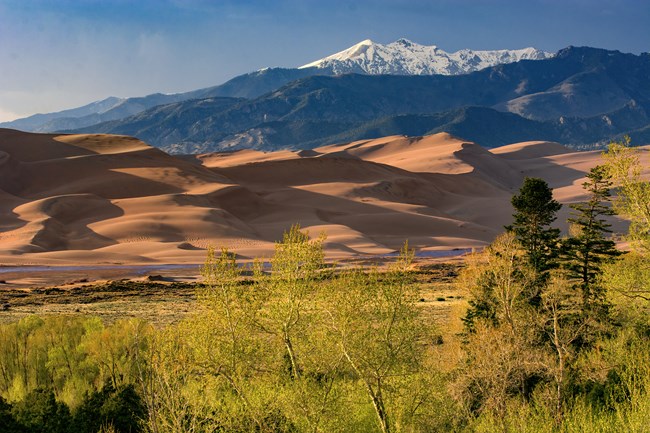
NPS/Patrick Myers How Were the Great Sand Dunes Formed?The dunes were formed by the right combinations of wind, water, and sediment. Creeks and streams brought in large amounts of sediment and sand into the valley. Wind then blew the sand toward the bend in the Sangre de Cristo Mountains, where opposing storm winds helped squeeze the sand into the tall dunes you see today. While this explanation does answer in the question above, the story of how the Great Sand Dunes were formed is much more complex, and as new research discoveries occur each year, is continually evolving. Below is a summary of what most geologists currently understand to be the broad series of events that took place in the formation of these massive dunes. Uplift of the San Juan and Sangre de Cristo MountainsThrough the breaking apart and movement (rifting) of large surface plates on Earth's surface, the Sangre de Cristo Mountains were uplifted in the rotation of a large plate. Fossils from the bottom of an ancient sea are now preserved in high layers of rock in the Sangre de Cristos, illustrating the scale of the uplift. The San Juan Mountains were created through volcanic activity. With these two mountain ranges in place, the San Luis Valley was born, covering an area roughly the size of the state of Connecticut. 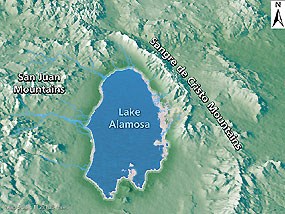
NPS Illustration Lake AlamosaIn 2002, geologists discovered lake shoreline deposits on hills in the southern part of the valley, confirming theories of a huge lake that once covered much of the San Luis Valley floor. They named this body of water "Lake Alamosa" after the largest town in the valley. Lake Alamosa suddenly receded after its extreme water pressure broke through volcanic deposits in the southern end of the valley. The water then drained through the Rio Grande River, likely forming the steep Rio Grande Gorge near Taos, New Mexico. 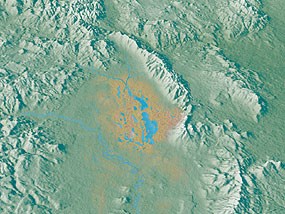
NPS Illustration Lake Alamosa RemnantsAfter Lake Alamosa drained away, smaller lakes still covered the valley floor, including two broad lakes in the northeastern side of the valley. Streams from both mountain ranges have continued to bring sand to the depressions where the lakes form. In the past, this included the Rio Grande. 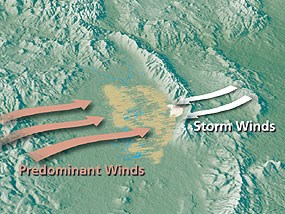
NPS Illustration Winds of the ValleyWhen the lakes periodically dry, sand left behind blows with the predominant southwest winds toward a low curve in the Sangre de Cristo Mountains. The wind funnels toward three mountain passes here - Mosca, Medano, and Music Passes - and the sand accumulates in this natural pocket. 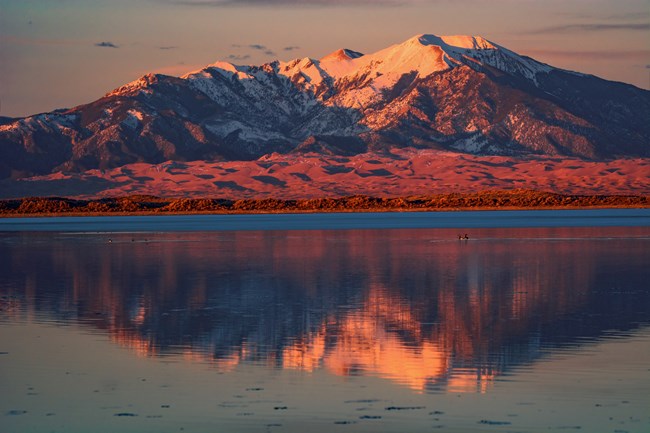
NPS/Patrick Myers Playa Lakes and WetlandsAs time went on, the wetlands and playa lakes (lakes that grow and shrink periodically with water availability) played an important role in the formation of the dunes. Much of the sediment that had been brought into the valley from the mountains was unsorted, having a mixture of grain sizes and materials, including muds, silts, clays, and most importantly sands. These smaller bodies of water and seasonal lakes helped sort the sand from the rest of the sediment. 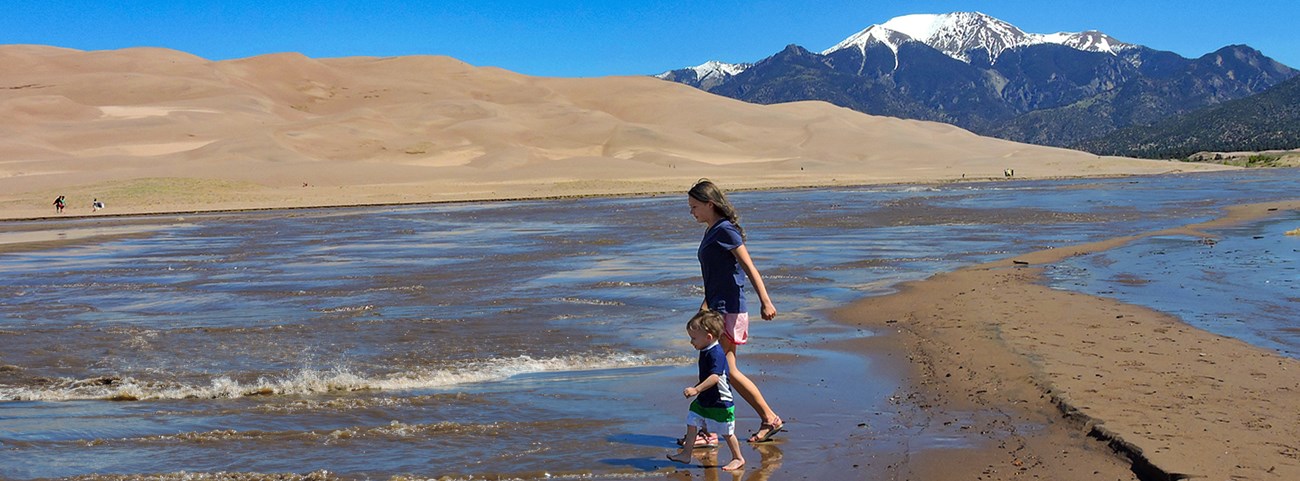
NPS/Patrick Myers Mountain StreamsEven with the opposing storm winds, most sand is still blown toward the mountain ranges. Here, two seasonal mountain streams, Medano Creek and Sand Creek, capture sand from the mountain side of the dunefield and carry it around the dunes and back to the valley floor. The creeks then disappear into the sand sheet, and the sand blows back into the dunefield. Barchan and transverse dunes form near these creeks. Water from these creeks then reappear in near the southwestern edge of the park, feeding into the wetland and playa lake systems. Learn more about the hydrology of Great Sand Dunes. 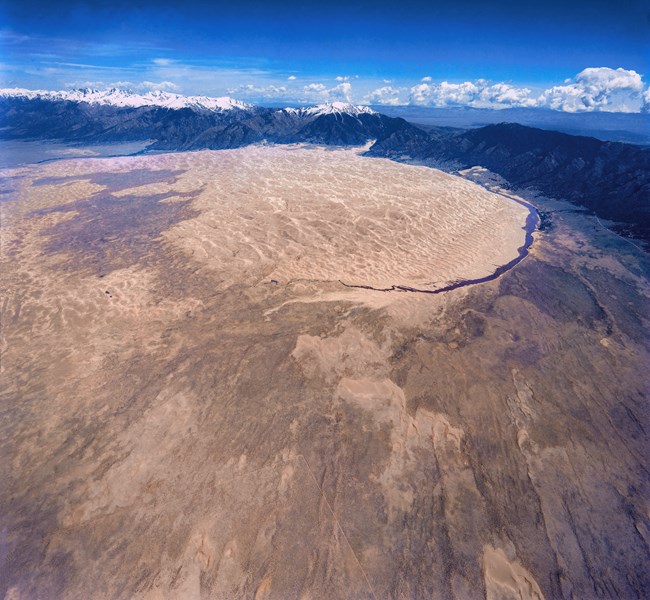
NPS Photo A Perfect StormThis combination of opposing winds, a huge supply of sand from the valley floor, and the sand recycling action of the creeks, are all part of the reason that these are the tallest dunes in North America. There are other dunes in Colorado, and in most western states in the US, but none as tall (741feet/ 226 meters) and none as dramatic. Here giant dunes rise in front of the alpine Sangre de Cristo Mountains, while streams flow across the sand seasonally, making for an unusual and unexpected sight. 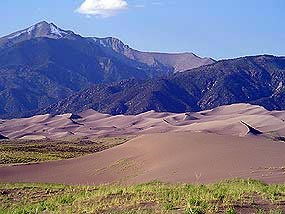
NPS/Scott Hansen Are the dunes still growing? How much do they change over time?Currently, there is enough vegetation on the valley floor that there is little sand blowing into the main dunefield from the valley. However, even today there are still some small parabolic dunes that originate from the playa lakes in the sand sheet and migrate across grasslands, joining the main dunefield. At other times, some of these migrating dunes become covered by grasses and shrubs and stop migrating. This limits the amount of new sand entering the main dunes system. 
William Henry Jackson - 1873 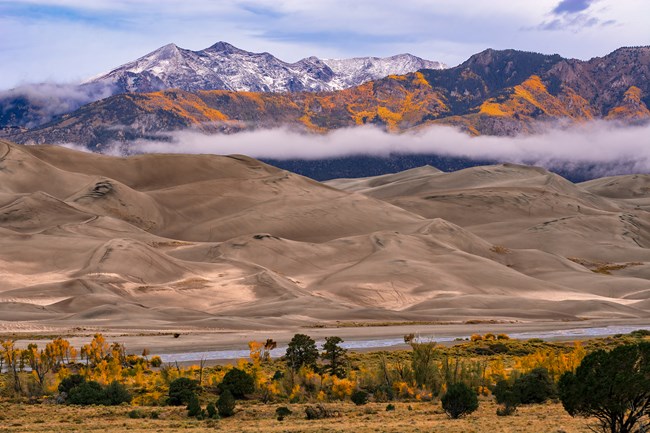
NPS/Patrick Myers How old are the dunes?Scientists don’t yet know a precise age and estimates have changed over time. At one time they were thought to be very young and the result of glacial outwash. We have since learned that the dune sand extends hundreds of feet into the subsurface, so they are older than initially believed. The dune sand begins just above the clay deposits of Lake Alamosa, so if Lake Alamosa disappeared about 400,000 years ago, then there have been dunes here since then. It is also possible that there is more dune sand under the lake deposits. We haven’t drilled that deep yet.
Visit our keyboard shortcuts docs for details
Have you ever heard sand sing? Listen to 15 seconds of this unusual phenomenon! Just as our own voices are made by air moving through a vibrating vocal chords, a deep humming sound is made at Great Sand Dunes as air is pushed through millions of tumbling sand grains during an avalanche. Avalanches occur naturally during storms, but can also be created by people pushing sand down a dune face. In the 1940s, one of Bing Crosby's musical hits was "The Singing Sands of Alamosa." Similar TopicsYou may also learn about geological components of the Great Sand Dunes system, hydrology of Great Sand Dunes, and the variety of dune types in the park. Selected Research PapersGeologic Map of Great Sand Dunes National Park (USGS/Madole, VanSistine, Romig; 2016) 2007 Rocky Mountain Section Friends of the Pleistocene Field Trip: Quaternary Geology of the San Luis Basin of Colorado and New Mexico, September 7–9, 2007 (USGS online publication) Michael N. Machette, Mary-Margaret Coates, and Margo L. Johnson Geoindicator: Dune Formation and Reactivation (web page, Global Change Research and Information Office) |
Last updated: May 1, 2025
